Day Trips To Find Antique Fruit
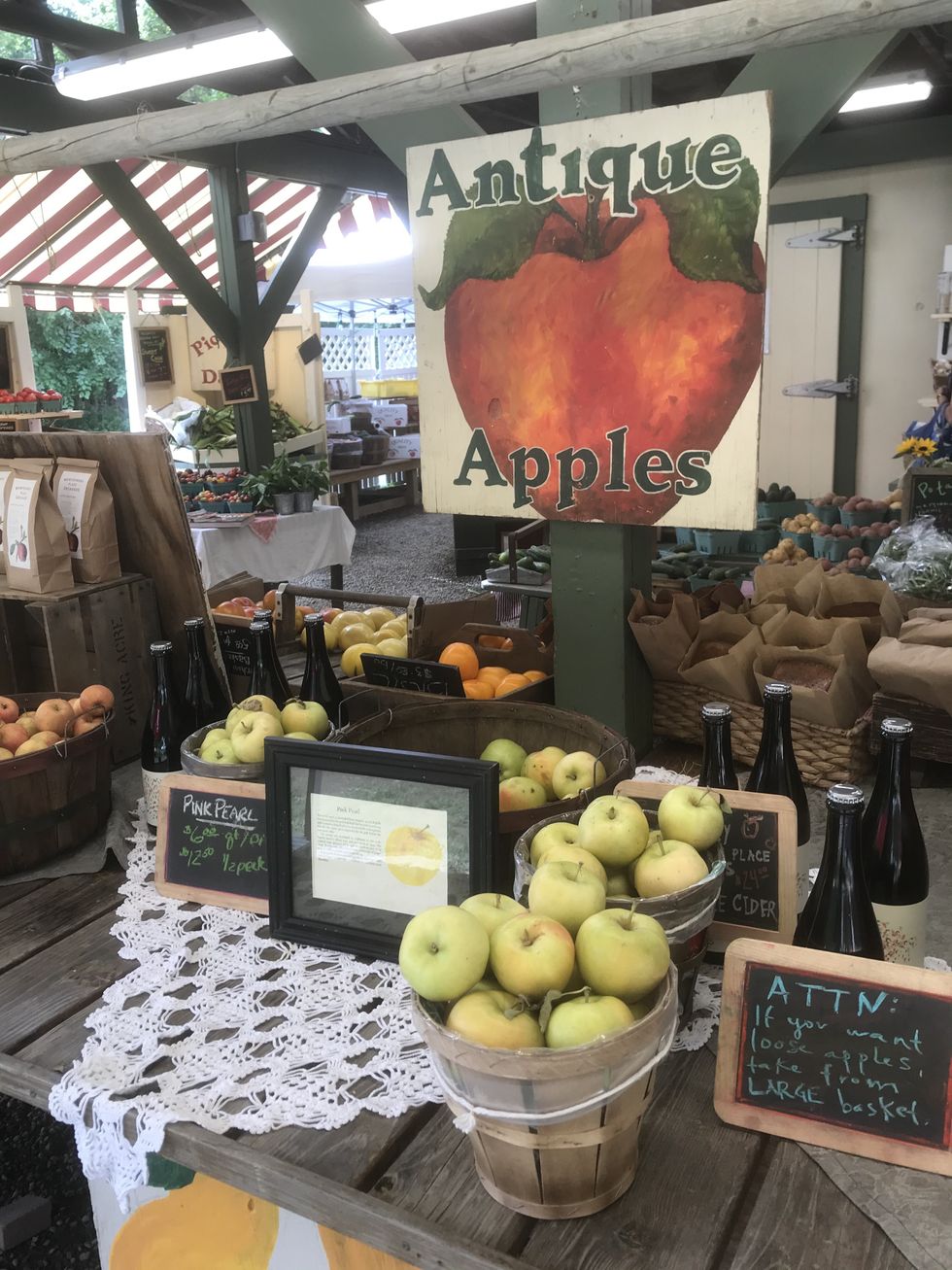
If you’re aching for adventure after a long quarantine, take a day trip to Red Hook, N.Y., and get antique apples at the Montgomery Place Orchards farm stand.
Photo by Cynthia Hochswender

There are excellent orchards nearby where you can pick fruit for yourself or buy it pre-picked. Windy Hill Farm in Great Barrington, Mass., has five varieties of apple on offer now and will make other varieties available (including some heirlooms) as they hit their peak. Find out what they’ve got at www.windyhillfarminc.com.
Ellsworth Hill Orchard in Sharon, Conn., has 10 varieties of apples, and ancillaries such as cider and doughnuts, www.ellsworthfarm.com.
But this autumn, when so many other travel opportunities are curtailed, I’m thinking about making a day trip to someplace, maybe an hour away, to pick apples (with masks on).
About one hour from my home in Lakeville, Conn., is the excellent Love Apple Farm in Ghent, N.Y., a town famous for its cherries in spring and apples in autumn. Love Apple Farm supplies outstanding fruit throughout the year to many of our area farm stands. At the moment they have four types of apples but in all they have 19 varieties that will ripen in the coming weeks, www.loveapplefarm.com.
When you hear the names of some of their varieties you might think, “Gee, how ordinary.” But once you’ve tasted a golden delicious or a red delicious from a local orchard you’ll understand why everyone went crazy for these apples in their early days (so much so that they were overbred and perhaps ruined).
When I want to go hunting for apples I go to Red Hook, N.Y., which is 40 minutes away and also has good restaurants and cute shops.
If you want to pick your own in Red Hook, you can try Greig Farm (www.greigfarm.com), which has 11 types of apples that will ripen between now and October.
Up the road a short ways is Hardeman Orchards (www.hardemanorchards.com), which has pick-your-own as well as pre-picked fruit plus doughnuts and hay rides. The website doesn’t have a full list of the available apples, and in fact doesn’t look like it’s been updated but I drove by it yesterday and it’s definitely open.
And yes, you read correctly that I drove by it, because my favorite apple source is just a few minutes up the road: Montgomery Place Orchards farm stand is at the T intersection of Routes 9G and 199 in Red Hook.
This is an exquisite little stand with a fascinating history. Montgomery Place is one of the historic Hudson River estates, and was, unusually, run by a woman, Janet Livingston Montgomery. A full history of the property, including the extensive and exquisite orchards, can be found on the Bard College website at www.bard.edu/montgomeryplace; the college recently purchased the property as well as the farm stand, which is more or less walking-distance away from the campus.
History is obviously an important part of Montgomery Place, so it’s appropriate that this is a farm that has an unusually high percentage of heirloom varieties. Heirloom or antique apples (like their cousins, the antique or heirloom tomatoes) are quirky breeds — often with funny names that are charming and romantic.
These are not like the grocery store apples that so often disappoint us. They are tender and delicious and sweet; they never made it into the Apple Big Leagues because they don’t travel well and often don’t have a long shelf life.
Many were originally found in distant places; someone loved them enough to carry a twig from their favorite tree to the New World and graft it so they could eat a favorite apple in their new but distant homeland.
Some of the antique apples at Montgomery Place have names like Pitmaston Pineapple (from Pitmaston in England); Cox Orange Pippin (created by Richard Cox in England in the 1800s using Ribston Pippin seeds) or its cousin, the Newtown Pippen, which was a favorite of Benjamin Franklin and is considered the oldest commercially grown native variety in America.
Some apple names hint at subtle deliciousness: Hidden Rose, Pink Pearl, Ashmead’s Kernel.
And of course Montgomery Place grows the Hudson River Valley’s own famous variety: the Esopus Spitzenberg, first developed in the town of Esopus in Ulster County, N.Y. This apple is a special treat, according to the Montgomery Place website, which warns that, “One problem is that it is a shy bearer and bears fruit only every other year.”
The sign at the farm stand promises that, yes, 2020 is an Esopus Spitzenberg year, and bushels should be available by Oct. 10. The full list of newer and older apples is listed on the sign at the farm stand, and you can call the stand to ask what’s in (845-758-6338). The season is just now beginning; there is still plenty of time to experience the full glory of the orchard.
And on your way back to the Tri-state area, if you no longer have flowers in your own garden to clip and bring inside, stop by the big white Battenfeld anemone farm (you’ll see the sign, you can’t miss it) and stop in to buy a bundle, wrapped with rubber bands and reasonably priced and sold on the honor system.
Stacks of old New York Times pages are on a nearby table so you can wrap your flowers; it’s a good idea to have a container with some water in your car to help the blossoms survive your drive home.
Wes Allyn breaks away from the St. Paul defense for a reception touchdown Wednesday, Nov. 26.
BRISTOL — The Gilbert/Northwestern/Housatonic co-op football team ended the season with a 34-0 shutout victory over St. Paul Catholic High School Wednesday, Nov. 26.
It was GNH’s fourth consecutive Turkey Bowl win against St. Paul and the final game for 19 GNH seniors.
The Yellowjacket defense played lights out, holding St. Paul’s offense to 73 total yards and forcing three turnovers. Owen Riemer and Tyler Roberts each caught an interception and Jacob Robles recovered a fumble.

QB Trevor Campbell threw for three touchdowns: one to Wes Allyn, one to Cole Linnen and one to Esten Ryan. GNH scored twice on the ground with rushing touchdowns from Linnen and Riemer.
The game concluded in some confusion. A late run by Linnen ended when he was tackled near the end zone. The ball was spotted at the one-yard line and GNH took a knee to end the fourth quarter with the scoreboard reading 28-0. After the game, Linnen’s run was reassessed as a touchdown, and the final score was adjusted to 34-0.

Coach Scott Salius was thankful that his team went out on a high note. “We’re one of the few teams in the state that will finish with a win.” He commented on the “chippiness” of this year’s Thanksgiving matchup. “We have started a true rivalry.”
GNH won four of the last five games and ended with a record of 5-5.
“Battling back from 1-4, huge turnaround. I couldn’t be happier,” said GNH captain Wes Allyn after the win. “Out of the four years I’ve been playing, undefeated on Thanksgiving. No one will ever take that away from me.”

Looking back on his final varsity season, Nick Crodelle said he will remember “practice, complaining about practice, and getting ready for the games. Game day was a lot of fun.”
Hunter Conklin said ending on a win “feels great” and appreciated his time on the field with his teammates. “There’s no one else I’d rather do it with.”
“I’m so thankful to have these guys in my life,” said Riemer. “It’s emotional.”
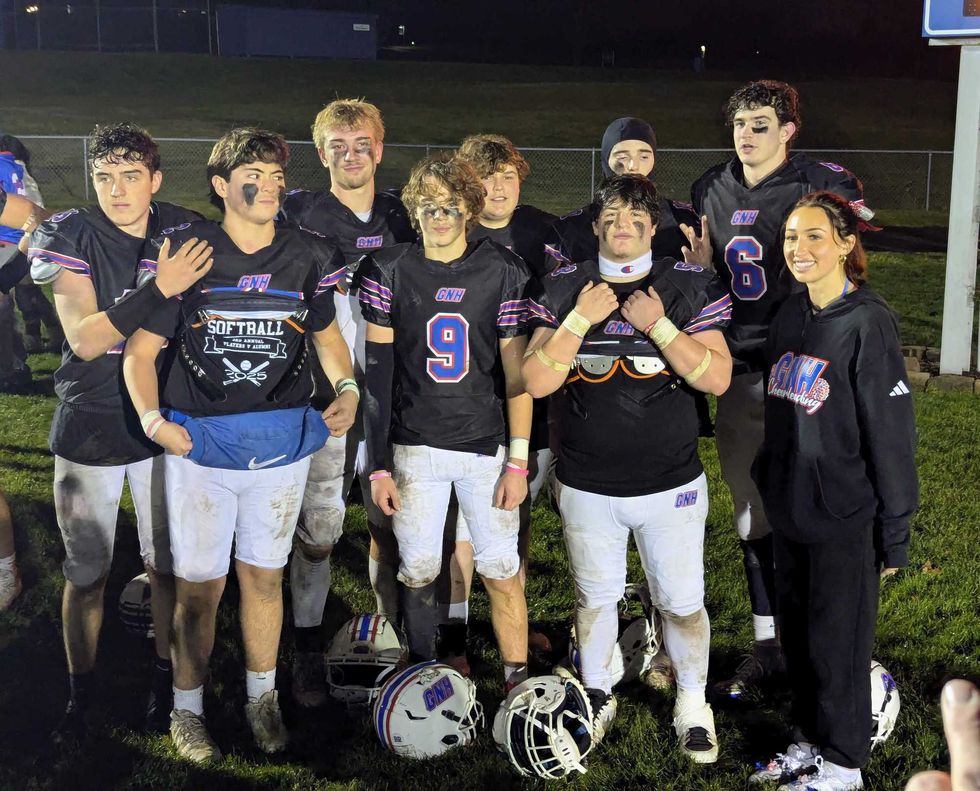
“Once Upon a Time in America” features ten portraits by artist Katro Storm.
The Kearcher-Monsell Gallery at Housatonic Valley Regional High School in Falls Village is once again host to a wonderful student-curated exhibition. “Once Upon a Time in America,” ten portraits by New Haven artist Katro Storm, opened on Nov. 20 and will run through the end of the year.
“This is our first show of the year,” said senior student Alex Wilbur, the current head intern who oversees the student-run gallery. “I inherited the position last year from Elinor Wolgemuth. It’s been really amazing to take charge and see this through.”
Part of what became a capstone project for Wolgemuth, she left behind a comprehensive guide to help future student interns manage the gallery effectively. “Everything from who we should contact, the steps to take for everything, our donors,” Wilbur said. “It’s really extensive and it’s been a huge help.”
Art teacher Lilly Rand Barnett first met Storm a few years ago through his ICEHOUSE Project Space exhibition in Sharon, “Will It Grow in Sharon?” in which he planted cotton and tobacco as part of an exploration of ancestral heritage.
“And the plants did grow,” said Barnett. She asked Storm if her students could use them, and the resulting work became a project for that year’s Troutbeck Symposium, the annual student-led event in Amenia that uncovers little-known or under-told histories of marginalized communities, particularly BIPOC histories.
Last spring, Rand emailed to ask if Storm would consider a solo show at HVRHS. He agreed.
And just a few weeks ago, he arrived — paints, brushes and canvases in tow.
“When Katro came to start hanging everything, he took up a mini art residency in Ms. Rand’s room,” Wilbur said. “All her students were able to see his process and talk to him. It was great working with him.”
Perhaps more unexpected was his openness. “He really trusted us as curators and visionaries,” Wilbur said. “He said, ‘Do with it what you will.’”
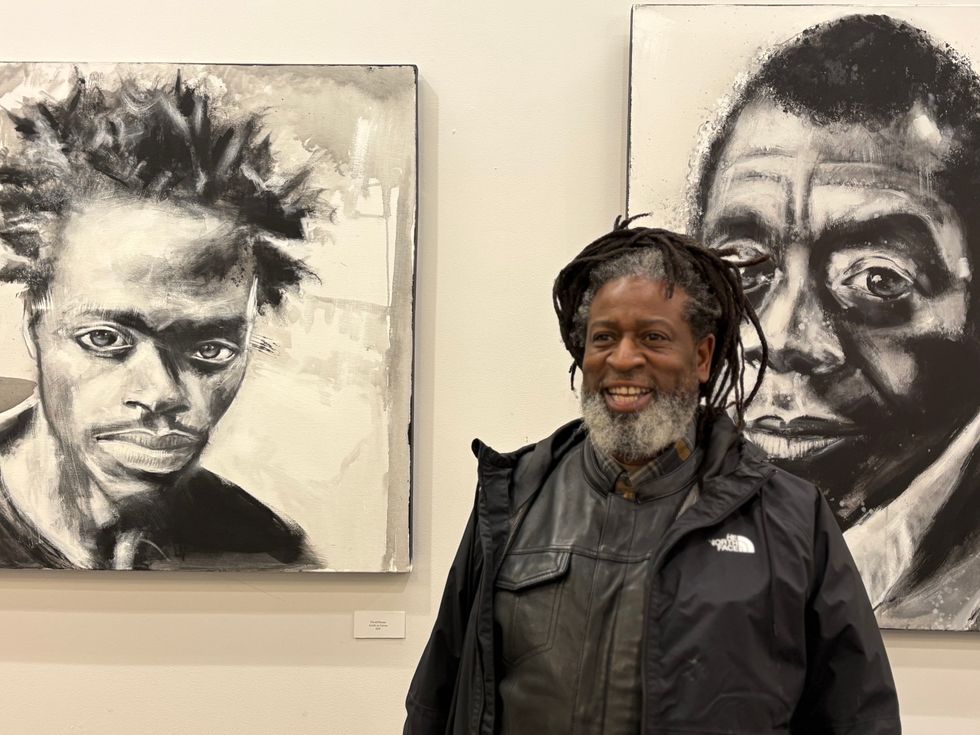
Storm’s artistic training began at New Haven’s Educational Center for the Arts. His talent earned him a full scholarship to the Arts Institute of Boston, then Boston’s Museum School, where he painted seven oversized portraits of influential Black figures — in seven days — for his final project. Those works became the backbone of his early exhibitions, including at Howard University’s National Council for the Arts.
Storm has created several community murals like the 2009 READ Mural featuring local heroes, and several literacy and wellness murals at the Stetson Branch Library in New Haven. Today, he teaches and works, he said, “wherever I set up shop. Sometimes I go outside. Sometimes I’m on top of roofs. Wherever it is, I get the job done.”
His deep ties to education made a high school gallery an especially meaningful stop. “No one really knew who these people were except maybe John Lennon,” Storm said of the portraits in the show. “It’s really important for them to know James Baldwin and Shirley Chisholm. And now they do.”
The exhibition includes a wide list of subjects: James Baldwin, Shirley Chisholm, Redd Foxx, Jasper Johns, Marilyn Manson, William F. Buckley, Harold Hunter, John Lennon, as well as two deeply personal works — a portrait of Tracy Sherrod (“She’s a friend of mine… She had an interesting hairdo”) and a tribute to his late friend Nes Rivera. “Most of the time I choose my subjects because there are things I want to see,” Storm said.
Storm’s paintings, which he describes as “full frontal figuratism,” rely on drips, tonal shifts, and what feels like emerging depth. His process moves quickly. “It depends on how fast it needs to get done,” he said. “Sometimes I like to take the long way up the mountain. Instead of doing an outline, I just start coloring, blocking things off with light and dark until it starts to take shape.”
He’s currently in a black-and-white phase. “Right now, I’m inspired by black and white, the way I can really get contrast and depth.”
Work happens on multiple canvases at once. “Sometimes I’ll have five paintings going on at one time because I go through different moods, and then there’s the way the light hits,” he said. “It’s kind of like cooking. You’ve got a couple things going at once, a couple things cooking, and you just try to reach that deadline.”
For Wilbur, who has studied studio arts “ever since I was really young” and recently applied early decision to Vassar, the experience has been transformative. For Storm — an artist who built an early career painting seven portraits in seven days and has turned New York’s subway corridors into a makeshift museum — it has been another chance to merge artmaking with education, and to pass a torch to a new generation of curators.
Le Petit Ranch offers animal-assisted therapy and learning programs for children and seniors in Sheffield.
Le Petit Ranch, a nonprofit offering animal-assisted therapy and learning programs, opened in April at 147 Bears Den Road in Sheffield. Founded by Marjorie Borreda, the center provides programs for children, families and seniors using miniature horses, rescued greyhounds, guinea pigs and chickens.
Borreda, who moved to Sheffield with her husband, Mitch Moulton, and their two children to be closer to his family, has transformed her longtime love of animals into her career. She completed certifications in animal-assisted therapy and coaching in 2023, along with coursework in psychiatry, psychology, literacy and veterinary skills.
Le Petit Ranch operates out of two small structures next to the family’s home: a one-room schoolhouse for animal-assisted learning sessions and a compact stable for the three miniature horses, Mini Mac, Rocket and Miso. Other partner animals include two rescued Spanish greyhounds, Yayi and Ronya; four guinea pigs and a flock of chickens.
Borreda offers programs at the Scoville Library in Salisbury, at Salisbury Central School and surrounding towns to support those who benefit from non-traditional learning environments.
“Animal-assisted education partners with animals to support learning in math, reading, writing, language and physical education,” she said. One activity, equimotricité, has children lead miniature horses through obstacle courses to build autonomy, confidence and motor skills.
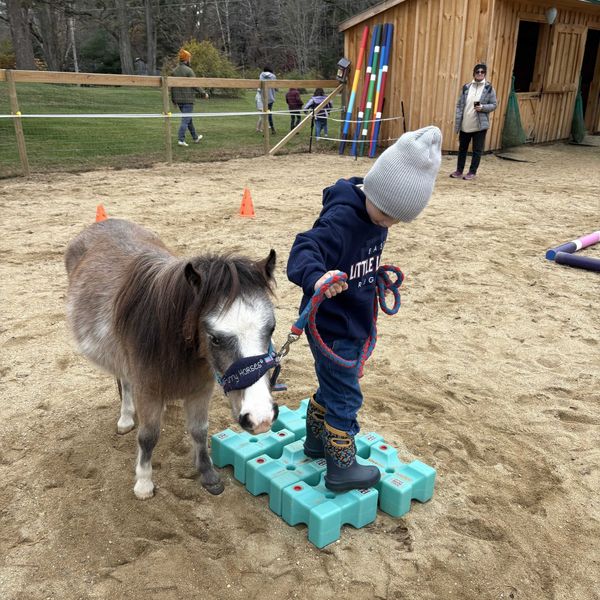
She also brings her greyhounds into schools for a “min vet clinic,” a workshop that turns lessons on dog biology and measuring skills into hands-on, movement-based learning. A separate dog-bite prevention workshop teaches children how to read canine body language and respond calmly.
Parents and teachers report strong results. More than 90% of parents observed greater empathy, reduced anxiety, increased self-confidence and improved communication and cooperation in their children, and every parent said animal-assisted education made school more enjoyable — with many calling it “the highlight of their week.”
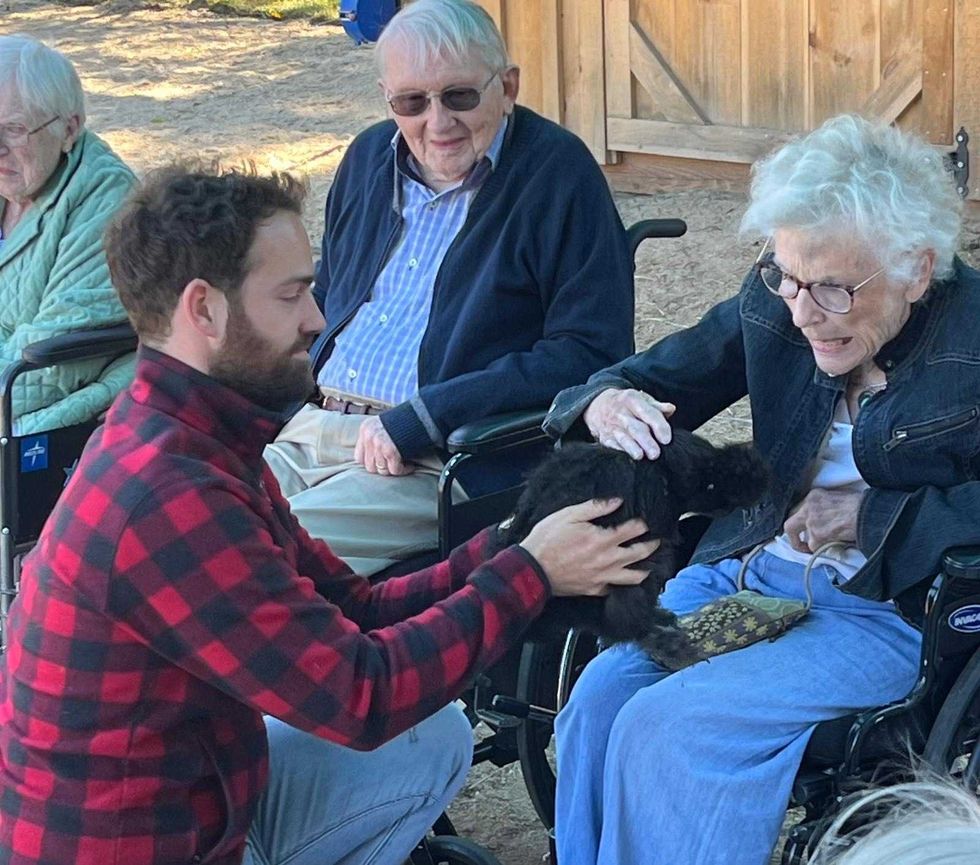
Le Petit Ranch also serves seniors, including nursing home residents experiencing depression, social withdrawal or reduced physical activity. Weekly small-group sessions with animals can stimulate cognitive function and improve motor skills, balance and mobility.
Families can visit Le Petit Ranch for animal- assisted afterschool sessions, Frech immersion or family walks. She also offers programs for schools, libraries, community centers, churches, senior centers and nursing homes.
For more information, email info@lepetitranch.com, visit lepetitranch.com, follow @le.petit.ranch on Instagram or call 413-200-8081.